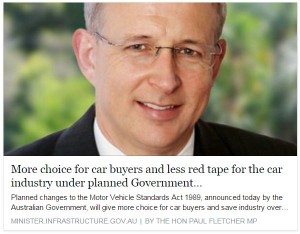Import Regulation changes for 2019 will include:
-
6 new evaluation criteria for the SEVS eligible model list
-
New rolling 25 Year Old Rule
-
Standard people movers ineligible for import from 2021
-
Cheaper and easier compliance
-
Independent quality inspections
-
“Rare” LHD vehicles won’t require RHD conversion
Further details:
2019 Vehicle Import Regulation Changes – Draft Legislation Announced
2019 Import Regulation Changes Media Release
Monitor current progress of the legislation here
Read our Blog, follow us on Facebook or add yourself to our Mailing List for the latest updates on the changes.
“More choice for car buyers and less red tape for the car industry under planned Government reforms to motor vehicle laws.”
Planned import regulation changes to the Motor Vehicle Standards Act 1989 announced on 10 February 2016 by the Australian Government will give more choice for car buyers and save industry over $70 million a year in lower regulatory compliance costs.
According to the Media Release, consumers will get more choice in three main ways:
Personal import of new motor vehicles
The law will be changed so that, from 2018, a consumer will be able to personally import a new car or motor cycle from another country with comparable standards to Australia’s, up to once every two years, if specified conditions are met.
The vehicle must be a motorcycle or right hand drive passenger vehicle, be no more than 12 months old and have no more than 500 km on the odometer.
The Australian Government will specify the countries considered to have comparable standards. Of the world’s right hand drive countries, Japan and the United Kingdom currently meet the standard. Other countries may be included upon reaching a comparable standard.
“Over one million new vehicles are sold in Australia today; over 90 per cent are imported and within two years all cars will be imported once Ford, General Motors and Toyota cease local manufacture”, Minister for Major Projects Paul Fletcher said.
“With around 30,000 vehicles a year expected to be personally imported, most Australians will continue to purchase vehicles directly imported by manufacturers and sold through their existing dealer networks.
”These new arrangements however will offer consumers greater choice. If a manufacturer chooses not to sell a particular model in Australia, a consumer may now have an option to source this model overseas.”
Improvements to existing schemes for specialist and non-standard vehicles
The changes will improve the existing arrangements for importing exotic, rare, classic, collectible and special purpose vehicles.
Today, individuals can import a car or motorcycle under concessional arrangements if it was manufactured before 1 January 1989. Keeping this fixed date would have steadily reduced the scope for importing genuine classic cars into the future.
A New 25 Year Rule
This will allow a vehicle which is at least 25 years old to be imported under these arrangements.
Updated SEVS
For newer vehicles, the Register of Specialist and Enthusiast Vehicles will be revamped, and limits on the number of vehicles that can be imported by each Registered Automotive Workshop will be removed.
In line with the Australian Government’s deregulation agenda, the changes will also simplify the pathways for importing non-standard vehicles used for special purposes, such as mining equipment, exhibition vehicles and vehicles not permitted for general road use.
While the Government is improving these existing schemes (under which used cars that meet specific criteria have long been able to be imported , and will continue to be able to be imported), it is not making any general change to the rules for used cars. As the Government announced in late 2015 in its response to the Harper Review, the Government has decided not to proceed with reducing parallel import restrictions on second-hand cars.
Removal of $12,000 special duty on imported used vehicles
The Government will amend the Customs Tariff Act 1995 to remove the $12 000 special duty on imported used vehicles from 2018.
“Although this duty is not often applied, it is on the statute books, costing more to administer than it raises—and is seen by consumers as a hurdle to importing second hand cars even in the specific circumstances where such imports are permitted. By removing this duty, we will provide more options for Australian consumers,” Mr Fletcher said.
Industry will enjoy lower regulatory compliance costs, as these changes to the Motor Vehicle Standards Act will align Australian rules more closely with international vehicle standards. This will reduce regulatory costs for manufacturers while maintaining high standards for vehicle safety and environmental performance.
“Motor vehicle manufacturing is a global industry where global standards apply—so it makes sense, and saves money, for Australia to use the global standards as much as possible,” Mr Fletcher said.
The changes will also simplify the importation and certification arrangements for vehicles, to improve efficiency and remove unnecessary red tape for businesses.
Under the new law there will no longer be a requirement to physically affix an identification plate to vehicles. Instead the vehicle’s details will be entered on a new Register of Approved Vehicles—an online, publicly searchable database of new and used vehicles approved for use in Australia. This measure will save manufacturers an estimated $18 million per year.
The import regulation changes announced in 2016 follow an extensive consultation process undertaken as part of the review announced in 2014. Legislation to implement the changes will be introduced into Parliament in 2016.
For further information visit www.infrastructure.gov.au/vehicles/mv_standards_act
April 2016 Update — Further industry consultation was undertaken in Canberra at the end of March 2016, to work out some of the practical issues in applying the proposed changes. However this was more a request for information from stakeholders rather than any extra detail about implementation as had been hoped.
The early election in mid 2016 will obviously have an impact on the implementation timeframe and the import regulation changes themselves. We will report further updates as they become available.
Join our Mailing List or follow us on FaceBook to stay in touch with the latest news.
That’s the Media Release… So what will the vehicle import regulation changes REALLY mean for your next car ?
From 2018 private individuals will be able to personally import a new car or motor cycle from another country with comparable standards to Australia’s, up to once every two years, if specified conditions are met.
To meet the new vehicle importation rules, a vehicle must:
-
be a motorcycle or right hand drive passenger vehicle
-
be less than 12 months old (less than 5 years old was originally suggested) and;
-
have no more than 500 km on the odometer (less than 4,000 km was originally suggested).
What does this mean to “new” vehicle imports ?
-
A member of the public can import 1 vehicle this way every 2 years
-
Right Hand Drive vehicles and motorbikes are allowed
-
Only from countries with equivalent or better standards
-
Vehicle must be less than 12 months old and have less than 500 kms on the odometer
The Australian Government will specify the countries considered to have comparable standards. Of the world’s right hand drive countries, Japan and the United Kingdom currently meet the standard – but others may be added at a later date.
The Specialist and Enthusiast Vehicle Scheme (SEVS) and Registered Automotive Workshop Scheme (RAWS)
Changes are planned to simplify the import process for exotic, rare, classic, collectible and special purpose vehicles.
The $12,000 special duty (essentially the penalty on used vehicles imported without an import approval) will be removed from 2018.
The used and low volume categories will be combined.
Read the latest Oct 11 2016 Update – NEW Vehicle Eligibility Criteria under SEVS 2018
5 eligibility criteria
-
High Performance
-
Superior environmental performance / hybrids
-
Disability features
-
Rare vehicles
-
Left Hand Drive, where right hand drive is not available



